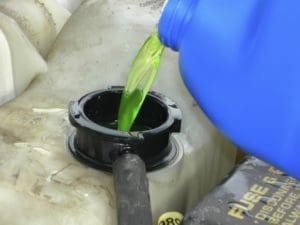
With concentrated antifreeze/coolant, it is important to have the proper mixture of antifreeze and water to ensure proper boil/freeze protection. For optimal results, here are some antifreeze dilution best practices to keep in mind.
Types of Glycols
First, let’s look at the concentrates. There are two primary types of concentrates: Ethylene Glycol (EG) and Propylene Glycol (PG). Glycol is a chemical compound belonging to the alcohol family. The main differences between EG and PG are the level of toxicity and the freeze point. Propylene Glycol has extremely low toxicity and is often found in cosmetics, personal care products, and other items that may come in contact with humans and other animals. Ethylene Glycol, on the other hand, is poisonous and must be handled with care to restrict human/animal exposure. But more PG is needed to reach the same freeze point as EG, making it less thermally efficient especially at lower temperatures.
Dilution Best Practices
Whether EG or PG is used, the mixture ratio is 50% glycol and 50% water. Sometimes in the south or warmer climates, 40% glycol is used; or in extreme cold, it may be as much as 60% glycol, but the 50/50 mix is most common. The correct ratio ensures proper boil/freeze protection for the environment in which it is used. Regardless of glycol type (PG or EG), make sure you always combine and mix it thoroughly.
For best (and simpler) results, you should use a volume-to-volume ratio, not weight. For example, if you want a 50/50 ratio, use one gallon of glycol for each gallon of water. The density of EG is greater than water. This means if you were to use weight, you would have to use a different calculation to get proper dilution. Likewise, it requires more PG to reach the same freeze point of EG. It is particularly important to follow the manufacturer’s instructions to achieve the proper PG content to ensure the desired boil/freeze protection.
 Water is Important
Water is Important
Water quality is another key component when following antifreeze dilution best practices. While tap water may be okay for drinking and cooking, that doesn’t mean it is ideal for coolants. Chloride and fluoride are typically added to tap water as a disinfectant to prevent waterborne infections and parasitic diseases. But those chemicals along with water hardness, iron, sulfates, and other things found in tap, well, or other feed waters can both affect the corrosion protection of the coolant and the overall stability. These, in turn, could cause incompatibilities in the cooling system and lead to engine failures or shortened life of the product.
For antifreeze/coolant purposes, avoid tap water and only use water free of minerals and other chemicals. Ideally, you should only use de-ionized (DI) water when mixing antifreeze/coolants. However, it can be acceptable to use reverse osmosis (RO) or distilled water depending on the immediacy of the need to mix coolant and availability in your area.
Lastly, there is no preference in the mixing order. You can either add the water to the concentrate or the concentrate to the water. The easiest process is to empty the entirety of the concentrate container into the receptacle you’re using to mix the antifreeze/coolant and then simply refill the concentrate container with the same volume of water and then add that to the mixing receptacle. This process ensures an antifreeze dilution best practice with a proper volume to volume ratio.
Assistance with Antifreeze Dilution
If you have questions regarding antifreeze/coolant mixing,
contact us. Our fluid experts will help you determine the proper dilution amounts for your antifreeze.
 With concentrated antifreeze/coolant, it is important to have the proper mixture of antifreeze and water to ensure proper boil/freeze protection. For optimal results, here are some antifreeze dilution best practices to keep in mind.
With concentrated antifreeze/coolant, it is important to have the proper mixture of antifreeze and water to ensure proper boil/freeze protection. For optimal results, here are some antifreeze dilution best practices to keep in mind.
 Water is Important
Water is Important